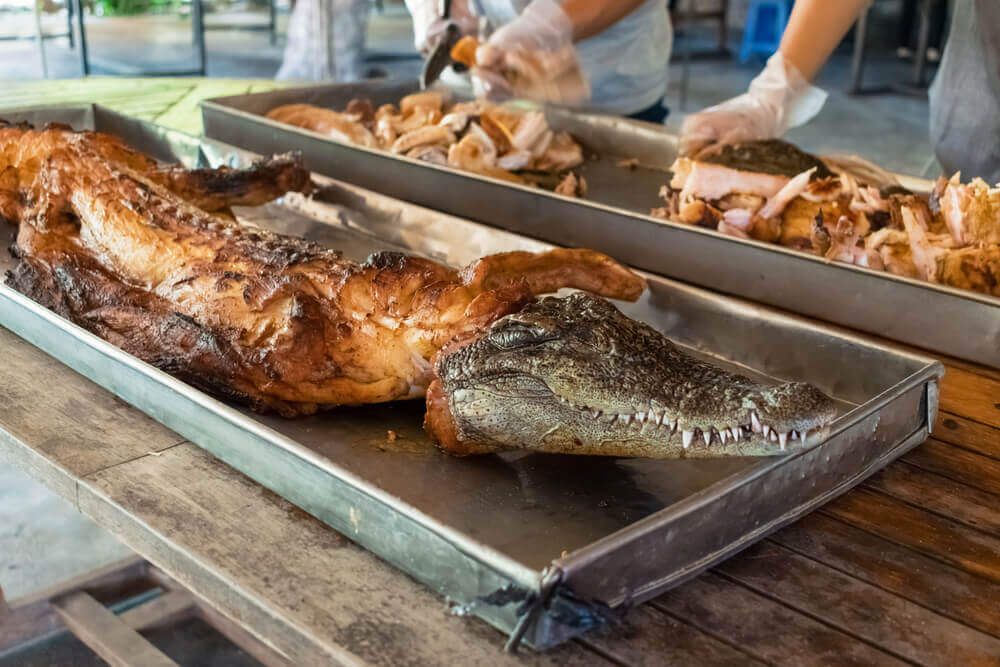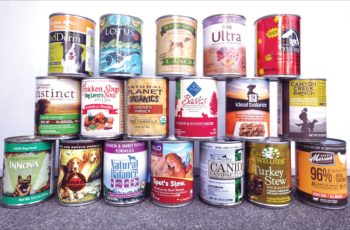Chicken, lean ground beef, turkey, and steak are good meats for dogs. Our canine friends need animal-based protein to grow. When done right, these meats can meet the growth demand of almost all breeds and ages of dogs sufficiently.
But there is more to it than meets the eye. Feeding dogs a variety of meat proteins and not sticking to just one food source is the route to optimum nutrition and good overall health. In this piece, we are going to look at everything meat and dogs to cover their nutritional bases.
Best Meats To Feed a Dog
We are going to review a total of 7 common meats, 4 exotic meats, and 4 game meats appropriate for our four-legged friends.
Organ meats, muscle meats, whole fish, and raw meaty bones are good types of meats if you are going for uncooked meals. However, we will only talk about meats you serve after cooking (boiling, steaming, etc.) for reasons provided in the next section.
All meats will have calories, fat, and protein listed right on top. For weight loss, choose meats with low fat and low calories. For better muscles or sick dogs, choose meats with high protein. For more active dogs, choose meats with high calories.
Let’s start with common meats. The best thing about common meats is that you will find plenty of commercial pet food products with these as the central ingredient. Such products ensure a balanced meal and also take out the need to handle and cook the meat yourself. But just in case you wish to cook something for your dog, we have provided critical pointers to help you.
1. Chicken Meat
Calories: Medium | Fat: Medium | Protein: High
Chicken is the most balanced of them all. It is nutritious, affordable, and contains a powerful amount of protein. It contains more protein than almost all common meats such as lamb, beef, pork, and salmon, with the notable exception of turkey. It also includes less fat per ounce than pork, beef, and even salmon and duck.
Chicken might have Salmonella bacteria. It is riskier than beef. Though dogs can get sick from this type of bacteria, it can also affect humans. Make sure you are sourcing your chicken from a reputable supplier and that you cook your chicken thoroughly.
The easiest way to serve chicken is to boil it. Roasts also work. The chicken stock can be used to cook rice or vegetables. An internal temperature of 165F is important to cook chicken.
2. Beef Meat For Dogs

Calories: High | Fat: High | Protein: Medium
Nutritious, affordable, and tasty – beef is one of the most popular meats in both, commercial and household meals for dogs. Beef for dogs should be from the hip or shoulder if you want quantity over tenderness. These cuts are usually cheaper but don’t vary much in terms of the overall nutritional value.
Ground beef is the cheapest option which doesn’t even require cutting.
Best way to serve? Roast if it’s a big cut at 145F then let it cool for 3 minutes. For ground beef, cook on a stovetop at 165F.
3. Lamb Meat
Calories: Comparatively low | Fat: High | Protein: High
Less popular in homes but lamb is quite common in commercial dog foods. Lamb is a high-protein and high-fat meat that can be quite rare in your local market. Its low caloric density makes it leaner than pork or beef while having more protein than both of them.
Roast it just like you would roast beef or pork. It doesn’t even require any sauce as lamb has a palatable taste. An internal temperature of 145F and then a resting period of 3 minutes is recommended.
4. Turkey
Calories: Comparatively low | Fat: Comparatively low | Protein: High
A lower-fat alternative to chicken, turkey’s taste is relatively famous among dogs. The generally more difficult preparation and the slightly higher cost both make turkey a less popular option compared to beef or chicken for dogs.
Care is important because, like chicken, turkey can also include Salmonella bacteria. Turkey also contains less tryptophan than chicken and pork – a component that leads to increased melatonin that is known to make mammals sleepy. Turkey making your dog sleepy is a myth because it contains a very small amount of tryptophan.
Roasting is easier than boiling a turkey bird. An internal temperature of 165F is recommended.
5. Salmon
Calories: Medium | Fat: High | Protein: Comparatively low
Heavy on fat and relatively low on protein, salmon might not seem to be the best choice for your dog. But this fat isn’t just about any fat. This fat is fish oil – loaded with Omega-3 fatty acids. Salmon meat is loaded with these fatty acids – stuff that your dog needs for better overall health including, particularly, relief from inflammation as well as a stronger immune system.
A well-done salmon is the only acceptable salmon for dogs. Salmon can be contaminated with a parasite called Nanophyetus salmincola. This parasite does not affect humans but dogs are prone to it. In fact, eating salmon and a few other fishes that swim upstream to breed are often known to fatally infect dogs when they eat them raw.
Medium, medium rare, steamed, or uncooked – these can prove to be fatal for your dog. Always cook all seafood at 145F internal temperature as per the USDA’s recommendation to avoid any health hazards for your dog.
6. Pork
Calories: Very high | Fat: Very high | Protein: Medium
Note: We are talking about fresh pork. Bacon and ham are not recommended for dogs.
Pork’s texture and taste are preferred by dogs and its affordability might be preferred by dog owners. Pork is rich in fat and calories while comparatively moderate in protein content among all dog-friendly meats.
Loading pretty much the same amount of protein as beef, having much more fat, and costing somewhat less, pork is great for dog owners looking to fatten their canine companions.
The most practical options are leg and shoulder cuts. Ground pork is also available in case you want to avoid the hassle of preparing a large chunk.
Cooking pork is similar to cooking beef, whether it’s a whole cut or ground.
7. Duck for Dogs
Calories: Medium | Fat: Medium | Protein: Comparatively low
Duck is remarkably tastier in most cases. Even picky eaters will always take a bite. Duck’s greasy meat looks very fatty but it has considerably lower fat than pork, lamb, or beef. It surely has more fat than other types of poultry though.
Duck’s especially low protein content makes it a bad choice if you wish to make your dog lose weight. Roasting a duck until an internal temperature of 165F is recommended.
There can be an availability or budgetary concern with ducks. We understand that. But if you can get a good deal on them, know that they are a perfectly fine source of protein for your canine friends.
Exotic Meat Proteins for Dogs To Eat
Let’s talk about 4 exotic meats now. Preparation and sourcing are going to be a tad bit difficult. These can be cooked as treats for your dog.
1. Alligator Meat for Dogs

Calories: Comparatively low | Fat: Comparatively low | Protein: Comparatively low
Seems alligator meat has found a profound new interest these past few years. Alligator meat provides fewer calories as a result of lesser fat than ducks. Otherwise, the meat is quite comparable. Alligator meat is popularly equated to that of chickens in terms of taste.
The only concerns are pricing and availability. Alligator meat is not available in the majority of towns across the US. And where it is, it is likely to cost significantly more than many other types of meats that are richer in proteins or overall calories.
2. Ostrich
Calories: Comparatively low | Fat: Medium | Protein: Medium
Saw ostrich meat at a specialty butcher’s and want to give this exotic treat to your canine friend? You are not alone! Ostrich is generally hard to source (and thus exotic) but it has a distinctive taste and texture.
Ostrich meat is also good for dogs with allergies. Lean protein from ostriches doesn’t contain much in terms of calories. If your dog is trying to lose weight then ostrich is a good exotic treat. Only a few commercial food options exist, if any, for ostrich meat.
Ostrich meat also contains a comparatively high amount of water per ounce.
3. Kangaroo Meat for Dogs
Calories: Comparatively low | Fat: Comparatively low | Protein: Medium
Kangaroo meat is good for dogs with food allergies. It would come as no surprise that a huge chunk of kangaroo meat is imported from Australia and that your closest market that has kangaroo meat has in all likelihood entirely unloaded its kangaroo meat stock from Australia directly.
Lean and low-calorie, kangaroo provides as much protein as beef. So, if availability and prices are not a concern then, by all means, go for it.
4. Goat Meat
Calories: Comparatively low | Fat: Comparatively low | Protein: High
Goat meat is pretty common around the world. It is often, together with lamb, called mutton. Unfortunately, Americans don’t get enough goats for themselves or their dogs. It’s a shame, really, because goats are a great source of protein with relatively less fat.
Tender goat cuts are tasty and dogs love them. At the same time, commercial goat farming doesn’t damage the environment in the way chicken or beef production does.
There is hardly any fat in goat even when it contains more protein than beef or pork. The only leaner meat that’s common is tilapia, but that lacks the protein content goat has.
Goat meat also contains a comparatively high amount of water per ounce.
Game Meats for Dogs To Eat
Wild territories indeed! Finally, we will go over 4 types of game meats. Game meats have to be stored in a freezer for at least three weeks before it’s lunch for them. This is largely a preventive measure against common threats such as trichinellosis.
1. Venison (elk or deer) Meat

Calories: Medium | Fat: Medium | Protein: Medium
Getting elk or deer meat is hard unless you are a hunter – in which case it’s obscenely cheap to hunt and prepare. Venison has a good texture and taste and dogs appear to love it consistently.
2. Bison Meat For Dogs
Calories: High | Fat: High | Protein: Comparatively low
Bison and venison fall in the hooved game category along with other animals such as rams. Buffalo burgers and steaks are becoming all too common in the US (not technically “buffalo” as those are a different species).
Bison meat is leaner than either pork or beef but it also provides lesser protein per ounce.
3. Pheasant
Calories: High | Fat: High | Protein: Very high
Pheasants (along with quails and wild doves) are upland birds. They differ from waterfowls (such as wild ducks and geese). You are more likely to find pheasant on the dinner table of a hunter than as an ingredient in a game bird dog food recipe.
Pheasant has a distinctively high amount of protein per ounce. They tickle the tastebuds of dogs in a zestier way than chicken does. Most dogs would love pheasants.
4. Rabbit Meat For Dogs
Calories: Medium | Fat: Medium | Protein: High
A small game such as a rabbit or hare is a good catch in many cases. Even if you are not a hunter, getting a rabbit is easy in farmers’ markets or even at a local butcher.
From a purely nutritional standpoint, rabbit is one of the few best protein sources for dogs. Rabbit’s fat distinctly improves the meat’s flavor and any dog will appreciate the taste. It has almost as much protein as a turkey.
5. Quail
Calories: High | Fat: High | Protein: Medium
Lower in protein and higher in fat, a quail packs more calories than the same amount of chicken. Quail can work as a great treat if your dog is fighting food allergies. It is a gamey bird but the dog won’t mind the taste difference much.
Some tips to keep in mind:
Is it Better to Feed your Dog Raw or Cooked Meat?

Protein Rich Foods: Chicken, Fish, Eggs, Beef, Seeds, Milk
Though it is reasonable why people seem to think that raw and uncooked meat is okay – it is not recommended for dogs. Their ancestors might have eaten raw food, but dogs have been domesticated and bred for a long while now.
A respectable amount of all the 400 or so breeds of dogs are breeds that were bred for a purpose, such as hunting, pointing, or guarding.
In fact, 53% of all dog breeds in US households are mixed-breed dogs and as per a 2017 study, the American Pet Products Association places this number at 44% while in the UK and Germany this number is 31-33%, and in Australia, it is nearly 50%.
After breeding, these dogs have been attuned to living in a household with humans. Humans have also found companionship to dogs very natural – domesticating and living with the wildest of dog breeds historically. Consequently, dogs have turned out to be a predominantly pet species barring a few breeds or localities.
The selective breeding of dogs to be perfect companions and to fulfill certain roles in human households and societies, in general, has led to dogs not being “wild” animals anymore. For a good part of dog companionship history, they have been fed not only meat but human foods, vegetables, prepared grains, bones, organ meats, and so on – including raw meat.
Processing and toxins
Cooking food removes the toxins present in it. A century ago, feeding raw meat would’ve been okay. But with the amount of processing and chemicals we have involving meats today, it is unsafe, to say the least, to directly feed raw meat to any pet animal whatsoever.
The majority of toxins such as chlorine in meat (present even in organic chicken shops) evaporate when heated.
Immunological Problems
Raw and uncooked meats can easily cross-contaminate a household or other food. This can lead to health problems in other pets as well as humans if their bodies are immunocompromised. Vets also don’t recommend raw meats where dogs share their home with young children for the same reasons.
Food Poisoning
Raw meats can cause food poisoning in dogs. Look out for a loss of appetite, diarrhea, vomiting, weakness, lethargy, tremors, and seizures. These are signs of food poisoning arising from raw meats in dogs.
Only Cooked Meat
What Muscle Meat Is Good for Dogs?
Muscle meats are an important source of animal-based protein for dogs. Apart from organ meats and bones, muscle meats are critical for healthy growth in any canine. Here are some amazing muscle meats to choose from depending on your availability and local pricing.
Is It Better to Boil or Bake the Meat for Dogs?
There is no right way here. Boiling is easier and mostly that’s the way people do it. Boiling, however, compared to baking, strips the meat of some of its flavor. If your dog likes the slightly drier texture of baked meat then that’s the way to go. For a quick meal, however, we would recommend boiled meats.
None offer any major advantage, including nutritional.
How Much Meat Should My Dog Eat?
If you can keep track of your dog’s food intake in terms of calories and raw protein then that’s a better measure than pounds of meat, as different animal meats have different calories, fats, and proteins.
Nevertheless, it is generally agreed that up to 2% of your dog’s body weight should be fed as meat. This applies most accurately to ground meat. If your dog is particularly active or if you are going for a “sports build”, then it makes sense to go higher than 2%. In most cases, however, 1.5% to 2% of your dog’s body weight will suffice.


